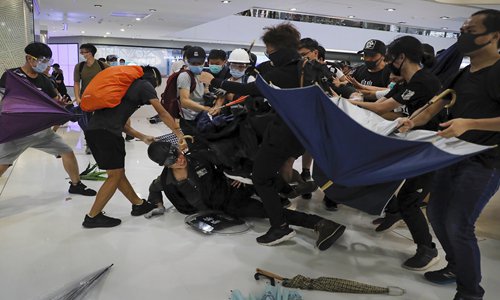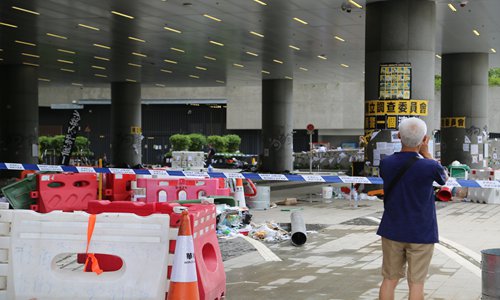HOME >> CHINA
Silent majority stands up
By Yang Sheng Source:Global Times Published: 2019/7/16 21:43:44
Hong Kong residents voluntarily inform police of mobs

A policeman is attacked by protesters inside a mall in Sha Tin District in Hong Kong Special Administrative Region on Sunday. Hong Kong Police Commissioner Stephen Lo Wai-chung strongly condemned the violence, vowing to track down those responsible for the clashes and hold them accountable. Photo: AP
The silent majority of Hong Kong residents have started to counter the violent protests by informing the police the suspect's photos and videos on social media networks, as the Hong Kong police have started to arrest suspects and investigate the cases.
Tang Tak Shing, chairman of Politihk Social Strategic, a Hong Kong-based NGO, told the Global Times on Tuesday that he and his team have opened a Facebook account for Hong Kong web users to upload evidence of violent protesters, including photos and videos that expose their violent activities, such as attacking policemen and smashing public facilities.
The Facebook reporting platform @sayno2hkrioter, which means "say no to Hong Kong rioter," has received more than 700,000 views and collected thousands of photos and videos publicly and privately. Tips include not only photos which show the face of some violent protesters but also the license plate number of vehicles which are suspected to have delivered weapons like steel bars to the protesters to attack the police.
Tang said his team will collect these information and hand them to the police authorities of Hong Kong and the mainland by the end of the school summer vacation. He said he hoped the mainland authorities would also take punitive measures against these people - for instance, forbidding their entry to the mainland and Macao, otherwise they could stir trouble elsewhere in China.
Not only Tang, many ordinary Hong Kong people are also handing in evidence to the police and they hope the police can control the situation and arrest the suspects to protect the residents' interests, according to some pro-establishment lawmakers of Hong Kong.
"In the past few weeks, every time after the so-called 'peaceful protest' by the opposition group and protesters, violent conflicts always happened. The non-stop violence shows that the police might have limited countermeasures to crack down on rioters. So as normal residents and taxpayers, we need to do something to assist the police," Tang said.
Observers noted that this kind of behavior shows that the silent majority is seriously offended by the violence and wants to contribute as the police face heavy pressure, and providing clues and evidence to the police is also an obligation of the citizens.
"The silent majority needs to take more visible actions to show that the protesters are unqualified to represent the city's public opinion," said Tian Feilong, an associate professor and a Hong Kong studies expert at Beihang University in Beijing.
The pro-establishment groups in Hong Kong who oppose violent protests and secessionism are organizing a massive rally at Tamar Park of Hong Kong on July 20. The theme of the rally is "It's time to stand up together to safeguard Hong Kong," which is intended to encourage the silent majority to voice opposition to the radical protesters. Another gathering to support the police took place at the same place on June 30, with a crowd of over 170,000.

A local resident takes photos of the LegCo building in Hong Kong which radical protesters stormed into Monday night. Photo: Chen Qingqing/GT
Attacking journalists
According to Hong Kong-based newspapers Takungpao and Wenweipo, during the protests, violent protesters also attacked journalists and ordinary residents who took photos, fearing their use as evidence against them.
Witness said protesters threw bricks at journalists of the two newspapers. Hong Kong-based television TVB also reported that its cameramen were attacked by five protesters on Sunday night in Sha Tin.
Violent protesters have also taken memory cards from cameramen if they believe the cameras record their faces or behavior.
Tang said that they are aware of the danger of collecting evidence of violent protesters, so he stressed that residents who voluntarily collect evidence for the police should do it safely.
Law enforcement
Violent protests undermine the rule of law, the Hong Kong police said in a statement sent to Global Times on Monday, and the police also provided further details about the unlawful assembly and violence that erupted Sunday night in Sha Tin.
According to the statement, police arrested 47 protesters, including 29 men and 18 women, for unlawful assembly, assault, obstruction, and weapons possession.
Among the 13 police officers sent to local hospitals for treatment, five still hospitalized.
On Sunday night, some protesters pried bricks from pavements, stocked up steel poles and other offensive weapons, demolished nearby railings, and blocked the roads using railings and other miscellaneous objects, according to the statement.
"The police, who are mandated to uphold the law of Hong Kong, will definitely stand at the forefront to maintain public safety and order," the statement said. The aim of police enforcement is to maintain law and order and uphold the rule of law, the Hong Kong Police said.
"Police will conduct an investigation into the recent violent acts and take action to bring those responsible to justice," read the statement.
Later Sunday evening, most of the demonstrators had dispersed. Those who remained hurled bricks, umbrellas and helmets at the police on the platform of shopping arcades near Wang Pok Street. Police were attacked while entering the arcades and used appropriate force to arrest violent protesters.
In a chatroom on Telegram, a social media platform used by the protesters to organize and send information, the Global Times reporter saw protesters sharing information on the location of police officers and strategies used to escape, which may prove that Sunday's violence was carefully orchestrated.
Posted in: POLITICS,HK/MACAO/TAIWAN